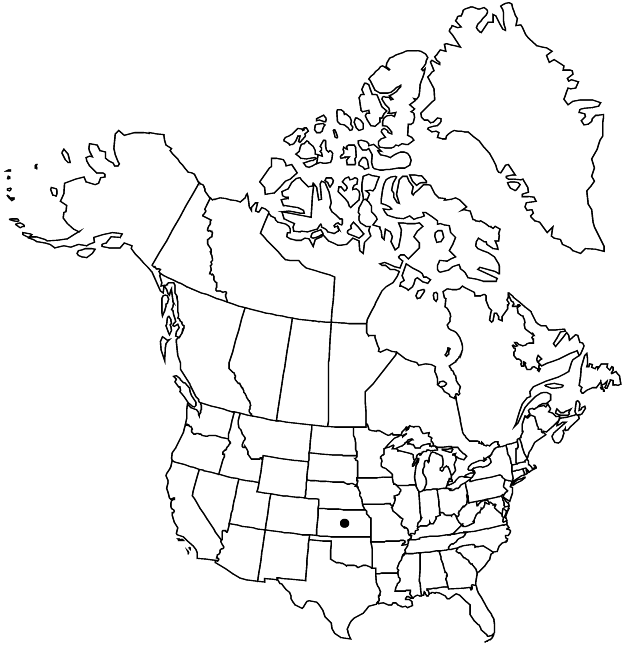Difference between revisions of "Eriogonum helichrysoides"
in B. D. Jackson et al., Index Kew., suppl. 4: 82. 1913.
FNA>Volume Importer |
FNA>Volume Importer |
||
| Line 15: | Line 15: | ||
|name=Eriogonum effusum subsp. helichrysoides | |name=Eriogonum effusum subsp. helichrysoides | ||
|authority=(Gandoger) S. Stokes | |authority=(Gandoger) S. Stokes | ||
| − | }}{{Treatment/ID/Synonym | + | }} {{Treatment/ID/Synonym |
|name=Eriogonum effusum var. rosmarnioides | |name=Eriogonum effusum var. rosmarnioides | ||
|authority=Bentham | |authority=Bentham | ||
| Line 33: | Line 33: | ||
|elevation=900-1100 m | |elevation=900-1100 m | ||
|distribution=Kans. | |distribution=Kans. | ||
| − | |discussion=<p>Eriogonum helichrysoides is limited to west-central Kansas (Ellis, Gove, Lane, Logan, Scott, and Trego counties). The plants’ dark green color and narrow leaf blades readily segregate the species from E. effusum.</p> | + | |discussion=<p><i>Eriogonum helichrysoides</i> is limited to west-central Kansas (Ellis, Gove, Lane, Logan, Scott, and Trego counties). The plants’ dark green color and narrow leaf blades readily segregate the species from <i>E. effusum</i>.</p> |
|tables= | |tables= | ||
|references= | |references= | ||
| Line 57: | Line 57: | ||
|publication year=1913 | |publication year=1913 | ||
|special status= | |special status= | ||
| − | |source xml=https://jpend@bitbucket.org/aafc-mbb/fna-data-curation.git/src/ | + | |source xml=https://jpend@bitbucket.org/aafc-mbb/fna-data-curation.git/src/8f726806613d60c220dc4493de13607dd3150896/coarse_grained_fna_xml/V5/V5_461.xml |
|subfamily=Polygonaceae subfam. Eriogonoideae | |subfamily=Polygonaceae subfam. Eriogonoideae | ||
|genus=Eriogonum | |genus=Eriogonum | ||
Revision as of 17:39, 18 September 2019
Shrubs, spreading, not scapose, 1.5–3(–4) × 3–8 dm, floccose and dark green. Stems spreading, often without persistent leaf bases, up to 1/3 height of plant; caudex stems absent; aerial flowering stems erect to slightly spreading, slender, solid, not fistulose, 0.02–0.04 dm, floccose. Leaves cauline, 1 per node; petiole 0.2–0.7 cm, floccose; blade linear to linear-oblanceolate, (2–)3–6 × 0.1–0.3 cm, densely tomentose abaxially, floccose and green adaxially, margins revolute. Inflorescences cymose, compact, 0.5–1.3(–1.6) dm; branches dichotomous, floccose to nearly glabrous; bracts 3, scalelike, triangular, 0.5–2 mm. Peduncles absent or erect, 0.5–2.5 cm, floccose. Involucres 1 per node, turbinate, 2.5–3 × 1–2 mm, floccose or glabrous; teeth 5, erect, 0.3–0.6 mm. Flowers 2–2.5(–3) mm; perianth white, becoming rose, glabrous; tepals connate proximal 1/4, essentially monomorphic, elliptic to obovate; stamens exserted, 2.5–4.5 mm; filaments sparsely pilose. Achenes brown, 2–2.5 mm, glabrous.
Phenology: Flowering Jul–Sep.
Habitat: Clay slopes or chalky limestone outcrops, mixed grassland communities
Elevation: 900-1100 m
Discussion
Eriogonum helichrysoides is limited to west-central Kansas (Ellis, Gove, Lane, Logan, Scott, and Trego counties). The plants’ dark green color and narrow leaf blades readily segregate the species from E. effusum.
Selected References
None.
